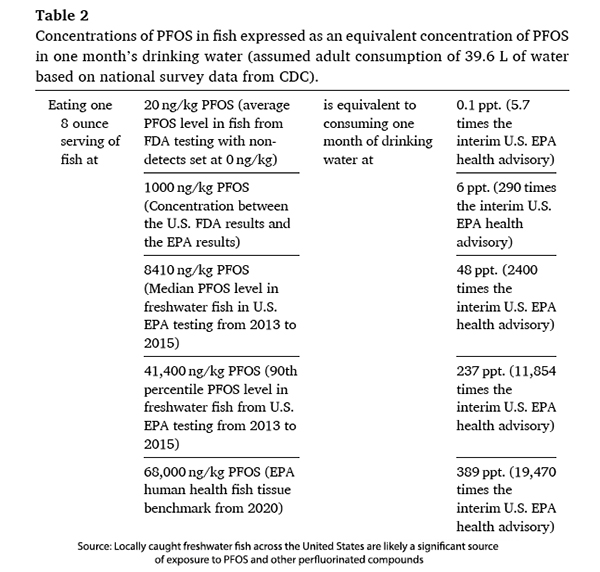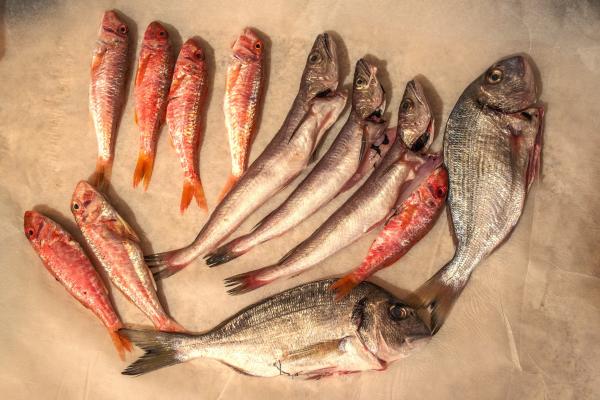The EWG study, published in Environmental Research, is a model. Rather than actually measure serum levels of PFOs, the group merely measured the quantity of PFOs in a fish multiplied by the number of fish eaten in a week and calculated a serum level. All models simplify reality by making assumptions; the fidelity of those assumptions to the real world measures how well the model mirrors reality. Let’s look at some of EWG’s assumptions.
The Dose Makes the Poison
The pharmacokinetics of PFOs in humans remains, at best, unsettled science. The EWG study admits that “no direct measurements of PFOS absorption through the gastrointestinal tract have been conducted in humans”
The EWG model, based on a chain of events, predicted that as more fresh-water fish was eaten, the serum level of PFOs would rise. There are two key assumptions in that chain that are problematic.
- no PFOS is removed through cooking
- the PFO concentration in fresh-water fish is consistent and known
The assumption that no PFOS are removed through cooking is wrong. As a study in Food Science and Nutrition reports, how fish is prepared does make a difference: Washing removed 74% of PFOs, while cooking provided other reductions -- “grilling (91%), steaming (75%), frying (58%), and braising (47%) comparing to uncooked sample.”
Yet the EWG authors claim,
“The calculations within the present study…assume that cooking does not materially impact PFAS and that 100% of the PFAS measured in fillets will result in exposure and subsequently impact serum levels. This could potentially overestimate exposure” [emphasis added]
They “knew“ this because the citation within the study suggests cooking seafood reduces PFAs by 29% based on a meta-analysis.
In calculating our exposure of PFOs, the EWG needed to know the potential amount of PFOs contained in fresh-water fish. They made use of two EPA assessments, the National Rivers and Streams Assessment (NRSA) done every five years, and the 2015 Great Lakes Human Health Fish Fillet Tissue Study. There was a wide range of values in those datasets, as EWG writes,
“Across both U.S. EPA’s datasets, the lowest total PFAS was 425 ng/kg and the highest was 286,767 ng/kg. The mean total PFAS was 20,870 ng/kg and the median was 11,880 ng/kg. … fish sampling from the Great Lakes Human Health Fish Fillet Tissue Study found overall higher levels of PFOS and total sum of detected perfluorinated compounds compared to the National Rivers and Streams Assessment.”
To its credit, EWG does provide that data in the supplemental materials. On the other hand, they resort to some blatant trickery. I took a moment to create a histogram of those values so that you can better see how skewed the data is – to the left, towards lower values.
The EWG researchers made a “judgment call” and used the median in their calculations. Using the mode, the most frequent value would have reduced their estimates 10-fold. Using the median is a “conservative” choice but introduces significant uncertainty, overestimating PFO levels in some species and underestimating them in others. The EWG’s judgment, to use median, “cooked the books,” as well as the fish.
Another source of uncertainty, as reported by the EWG researchers, is that the PFOS data is ten years old.
“Compared to data collected by the U.S EPA in 2008–2009, median PFOS levels decreased by 30 percent in the present data set collected just 5 years later. With decreasing use of PFOS in commerce, it is possible that PFOS levels in fish have continued to decrease, and our modeled serum impacts are an overestimate of the current median level of exposure.” [emphasis added]
So, in effect, EWG is adding overestimated PFOS levels to already-overestimated levels – hardly the hallmark of sound science.
How much fish do we eat?
Good question. The NHANES survey involving food recalls put our seafood consumption at about 18g/day; a high seafood eater has seafood once or more per week. As the EWG correctly notes:
“[T]he impact on serum from exposure to PFAS from dietary fish consumption may depend on how much one eats fish that are commercially sourced versus locally caught.”
That is because commercially sourced seafood contains very few PFOs, which is precisely why the EWG focuses on freshwater fish, again inflating the total amount of chemicals we may be consuming. Most freshwater fish from our lakes and streams is not in the commercial market but is eaten by anglers; only 5% of our seafood meets those criteria.
Do you see the pattern here?
According to the US Fish and Wildlife Service’s 2016 National Survey of Fishing, Hunting and Wildlife-Associated Recreation, 30.1 million Americans fish in freshwater; 18% fish the Great Lakes which the EWG singled out as having some of the highest PFO levels nationally. As it turns out, not all fish caught are kept. Anglers tend to keep for themselves or share with their family and friends some species, like salmon and catfish, more than others – roughly 60% of freshwater fish is “catch and release.” Ref needed
The EPA’s Estimated Fish Consumption Rates for the US Population and Selected Subpopulations reports that the 50th percentile of Americans eating freshwater fish consumes 35 grams weekly, the 90th percentile, while the high freshwater fish eaters 210 grams weekly. They note that “recreational or self-caught consumption rates vary regionally and are poorly understood, particularly for high-frequency consumers, making it difficult to support national-scale assessments.” [1]
“Weekly commercial fish consumption would impact serum levels approximately half as much as a single freshwater fish serving per year, based on the U.S. EPA results…”
 There is little concern for the 90%+ of us who are not anglers. For the anglers, it depends on how much of their catch they eat over a year. According to the EPA’s study of our fish consumption, the top 5% of anglers and their families and friends eating locally caught fish would be consuming that EWG’s toxic fish. We are talking about roughly 3 million individuals.
There is little concern for the 90%+ of us who are not anglers. For the anglers, it depends on how much of their catch they eat over a year. According to the EPA’s study of our fish consumption, the top 5% of anglers and their families and friends eating locally caught fish would be consuming that EWG’s toxic fish. We are talking about roughly 3 million individuals.
Subsistence Fishing
Let me quickly point out that 3 million individuals at risk are not trivial, but it certainly places “Eating one bass is equivalent to drinking PFOS-tainted water for a month” in perspective. The individuals most at risk are those who fish to put food on the table, not as a treat, but as their daily sustenance. These “food insecure” often overlap with indigenous Americans that continue to fish for cultural reasons. Subsistence fishing is a frequent finding among indigenous Americans in the Northeast and Alaska; in Alaska’s rural areas, nearly 100% of households use subsistence fishing. Subsistence fishing is also found in our urban areas; a study of fishing in Tampa Bay suggested that 11% of anglers were subsistence fishermen. Therefore, determining their numbers is complex, so it is fair to say that the 3 million number I offered might rise or fall if these individuals were easily identifiable. More importantly, the EWG study does not focus on this population, so beyond saying that they are the ones at the most significant risk, we cannot quantify that risk at all.
An Analogy and Perhaps a Sleight of Hand?
Unlike our public health agencies, EWG knows to craft a memorable message. In this instance, an analogy between eating one 8-ounce fish and drinking a month’s worth of “tainted” water.
 Table 2 shows a rising exposure to increasingly “toxic” fish. But the group’s analogy uses a value from FDA testing, not of freshwater fish, but commercially available seafood. That particular dataset is skewed by the presence of clams imported from China. [2]
Table 2 shows a rising exposure to increasingly “toxic” fish. But the group’s analogy uses a value from FDA testing, not of freshwater fish, but commercially available seafood. That particular dataset is skewed by the presence of clams imported from China. [2]
The FDA testing is consistent with the mean for freshwater fish, but if we were to use the median, as was used throughout EWG’s report, that same 8-ounce serving would be equivalent to twice the amount of water, two months of drinking water.
This may be a moot point because the EPA’s “interim drinking water health advisory value for PFOS, … assumes that 80% of exposure is coming from non-drinking water sources.” [3] Fish, commercial or recreational, is not a drinking water source, so acceptable values are higher.
Conflicts of Interest
The authors declare in a carefully crafted statement that warrants a moment of scrutiny they “have no known competing financial interests or personal relationships that could have appeared to influence the work reported in this paper.”
Not all conflicts are financial or social. All of the authors work or worked for EWG. The “conceptualization” of the study was by an EWG employee, and the sole academic was an intern from May through August 2022. Was there a shared focus that might influence the narrative presented?
EPA-FDA Advice about Eating Fish and Shellfish
“If you eat fish caught by family or friends, check for fish advisories. If there is no advisory, eat only one serving and no other fish that week. Some fish caught by family and friends, such as larger carp, catfish, trout, and perch, are more likely to have fish advisories due to mercury or other contaminants. State advisories will tell you how often you can safely eat those fish.”
All things considered, this is a set of fishy assumptions, calculations, and conclusions.
[1] “… the lowest consumption rates were among inland Midwest (12.4 g/day; 0.44 oz/day) and inland Great Lakes (14.6 g/day; 0.52 oz/day) adults, and the highest consumption rates were among coastal Northeast (24.5 g/day;0.86 oz/day) and coastal Pacific (22.1 g/day; 0.78 oz/day) adults.”
[2] There were no FDA reports on freshwater fish, nor could I find any EPA human health fish tissue benchmarks to support those highest PFO numbers.
[3] The EPA’s interim water standard is based upon” decreased immunity (i.e., decreased serum antibody concentrations after vaccination) in children in a human epidemiology study,” the most sensitive non-cancer effect they could identify. After accounting for variability in human response, the “EPA expects this critical effect to be protective of all other adverse health effects observed in humans.”
Source: Locally caught freshwater fish across the United States are likely a significant source of exposure to PFOS and other perfluorinated compounds Environmental Research DOI: 10.1016/j.envres.2022.115165




